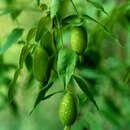en
names in breadcrumbs


Buckleya distichophylla, commonly called piratebush, is a flowering plant in the family Santalaceae, native to the Southern United States.[3] It is a rare plant,[4] found only in sporadic mountainous areas of North Carolina, Tennessee, and Virginia.[4][3]
Buckleya distichophylla is a deciduous shrub growing to heights of up to 15 feet (4.6 m), with leaves that are 2-4 inches in length requiring direct sunlight to grow.[5] Its flowers are 1 inch (2.5 cm) long with 4 yellow-green, long narrow bracts.[5] What makes the piratebush unique is in how it survives. The plant does not survive on photosynthesis only as its pale green leaves indicate less chlorophyll than other plants. In addition to photosynthesis, piratebush receives nutrients through parasitizing other species.[4][6] The plant is hemiparasitic, attaching itself to the root systems of other plants with structures called haustoria and draw nutrients through them.[4] Although originally thought to attach itself only to hemlock trees, it has since been determined that piratebush can attach to many different species.[4]
At present, piratebush has only been identified in mountainous areas of North Carolina, Tennessee, and Virginia.[4][3] The greatest concentration of the plant can be found within the Poor Mountain Natural Area Preserve atop Poor Mountain, approximately 2 miles (3.2 km) southwest of Roanoke in Roanoke County, Virginia.[6] The number of piratebush plants on Poor Mountain is greater than all of the others existing at other locations.[6] Although many other locations in the Appalachians feature habitats that seemingly would support piratebush, scientists have yet to determine why the plant exists in so few places.[4]
The plant was initially discovered and described as a member of the genus Borya in the olive family by Thomas Nuttall in 1818 along the French Broad River in the vicinity of Paint Rock in Western North Carolina. The plant was rediscovered in 1843 by Samuel Buckley with John Torrey classifying the plant as Buckleya distichophylla.[4][7]
Buckleya distichophylla, commonly called piratebush, is a flowering plant in the family Santalaceae, native to the Southern United States. It is a rare plant, found only in sporadic mountainous areas of North Carolina, Tennessee, and Virginia.
Buckleya distichophylla is a deciduous shrub growing to heights of up to 15 feet (4.6 m), with leaves that are 2-4 inches in length requiring direct sunlight to grow. Its flowers are 1 inch (2.5 cm) long with 4 yellow-green, long narrow bracts. What makes the piratebush unique is in how it survives. The plant does not survive on photosynthesis only as its pale green leaves indicate less chlorophyll than other plants. In addition to photosynthesis, piratebush receives nutrients through parasitizing other species. The plant is hemiparasitic, attaching itself to the root systems of other plants with structures called haustoria and draw nutrients through them. Although originally thought to attach itself only to hemlock trees, it has since been determined that piratebush can attach to many different species.
At present, piratebush has only been identified in mountainous areas of North Carolina, Tennessee, and Virginia. The greatest concentration of the plant can be found within the Poor Mountain Natural Area Preserve atop Poor Mountain, approximately 2 miles (3.2 km) southwest of Roanoke in Roanoke County, Virginia. The number of piratebush plants on Poor Mountain is greater than all of the others existing at other locations. Although many other locations in the Appalachians feature habitats that seemingly would support piratebush, scientists have yet to determine why the plant exists in so few places.
The plant was initially discovered and described as a member of the genus Borya in the olive family by Thomas Nuttall in 1818 along the French Broad River in the vicinity of Paint Rock in Western North Carolina. The plant was rediscovered in 1843 by Samuel Buckley with John Torrey classifying the plant as Buckleya distichophylla.
Buckleya distichophylla, comummente chamado arbusto pirata, é uma planta pertencente à família Santalaceae, nativa do sul dos Estados Unidos.[3] É uma planta rara,[4] encontrada apenas em áreas montanhosas da Carolina do Norte, Tennessee e Virgínia.[3][4]
A planta foi inicialmente descoberta e descrita como um membro do género Borya na família da oliveira por Thomas Nuttall em 1818 ao longo do rio French Broad, nas proximidades da Paint Rock, no oeste da Carolina do Norte. A planta foi redescoberta em 1843 por Samuel Buckley com John Torrey classificando a planta como Buckleya distichophylla.[4][5]
Buckleya distichophylla, comummente chamado arbusto pirata, é uma planta pertencente à família Santalaceae, nativa do sul dos Estados Unidos. É uma planta rara, encontrada apenas em áreas montanhosas da Carolina do Norte, Tennessee e Virgínia.
A planta foi inicialmente descoberta e descrita como um membro do género Borya na família da oliveira por Thomas Nuttall em 1818 ao longo do rio French Broad, nas proximidades da Paint Rock, no oeste da Carolina do Norte. A planta foi redescoberta em 1843 por Samuel Buckley com John Torrey classificando a planta como Buckleya distichophylla.
Buckleya distichophylla là một loài thực vật có hoa trong họ Santalaceae. Loài này được (Nutt.) Torr. mô tả khoa học đầu tiên năm 1843.[1]
Buckleya distichophylla là một loài thực vật có hoa trong họ Santalaceae. Loài này được (Nutt.) Torr. mô tả khoa học đầu tiên năm 1843.